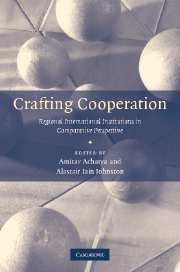Book contents
- Frontmatter
- Contents
- List of tables
- Notes on the contributors
- Acknowledgments
- 1 Comparing regional institutions: an introduction
- 2 Hanging together, institutional design, and cooperation in Southeast Asia: AFTA and the ARF
- 3 International cooperation in Latin America: the design of regional institutions by slow accretion
- 4 Crafting regional cooperation in Africa
- 5 Functional form, identity-driven cooperation: institutional designs and effects in post-Cold War NATO
- 6 Designed to fail or failure of design? The origins and legacy of the Arab League
- 7 Social mechanisms and regional cooperation: are Europe and the EU really all that different?
- 8 Conclusion: institutional features, cooperation effects, and the agenda for further research on comparative regionalism
- Bibliography
- Index
4 - Crafting regional cooperation in Africa
Published online by Cambridge University Press: 22 September 2009
- Frontmatter
- Contents
- List of tables
- Notes on the contributors
- Acknowledgments
- 1 Comparing regional institutions: an introduction
- 2 Hanging together, institutional design, and cooperation in Southeast Asia: AFTA and the ARF
- 3 International cooperation in Latin America: the design of regional institutions by slow accretion
- 4 Crafting regional cooperation in Africa
- 5 Functional form, identity-driven cooperation: institutional designs and effects in post-Cold War NATO
- 6 Designed to fail or failure of design? The origins and legacy of the Arab League
- 7 Social mechanisms and regional cooperation: are Europe and the EU really all that different?
- 8 Conclusion: institutional features, cooperation effects, and the agenda for further research on comparative regionalism
- Bibliography
- Index
Summary
Numerous attempts at creating formal regional organizations have failed in Africa, leaving a veritable organizational junkyard of unsuccessful attempts to reduce the continent's balkanization. The assumption has therefore been that regional cooperation has failed, and will continue to do so, in Africa because the domestic and regional environments are so different from Europe, which has the highest density of successful regional experiments. In fact, while the failures in crafting regional organizations have been numerous, there have also been occasional examples of dramatic success. In particular, the Organization of African Unity managed to establish an improbable continental norm that boundaries should not be altered and large parts of Africa had a common currency decades before the euro. More generally, African states continue to devote enormous amounts of time and energy to creating continental, regional, and bilateral treaties, organizations, and forums, suggesting by their revealed preferences that they do not believe that pursuing regional cooperation is fruitless.
In fact, regional cooperation is largely initiated and designed in Africa to promote the security and interests of rulers, rather than the more generally assumed goals of increasing the size of economic markets, ensuring the rights of citizens, or overcoming capricious national boundaries. The key to understanding the fate of regional cooperation in Africa is to discard the assumption that there is an inevitable conflict between sovereignty (or, more precisely, the prerogatives of individual leaders) and regional cooperation.
- Type
- Chapter
- Information
- Crafting CooperationRegional International Institutions in Comparative Perspective, pp. 129 - 144Publisher: Cambridge University PressPrint publication year: 2007
- 11
- Cited by

